Disclosure!
At The Daily Farming, your trust means everything. We use AI to help create some of our content, but every post is carefully reviewed and edited by real humans before it’s published.
Some of our images are AI-generated to help illustrate ideas, but everything you see is checked and approved by us.
Thanks for being here—we’re grateful for you!
Thinking of raising chickens in your backyard? You’re in the right place. But before you start dreaming about farm-fresh eggs and clucking companions, there’s one thing every chicken keeper needs—a reliable, comfy, and predator-proof coop.
A great chicken coop does more than give your hens a place to sleep. It keeps them safe, dry, and happy, which means more eggs and fewer problems. Whether you’re working with a tight space, a tight budget, or both, we’ve gathered 13 chicken coop ideas to inspire your next build.
Looking for something even smaller? Check out our guide to 17 Creative Small Chicken Coop Ideas for Your Backyard if you’re short on space. Or if you’re handy with tools, you’ll love these 16 Affordable DIY Chicken Coop Designs for Your Backyard—perfect for saving cash and customizing your coop.
In this post, we’ll break down:
- What makes a chicken coop truly functional
- Key things to consider before choosing a design
- Answers to the most common coop-building questions
- And of course, our favorite 13 chicken coop ideas for all kinds of setups
Let’s get into it—and find the perfect home for your feathered crew.
Before You Build – What to Know About Chicken Coops
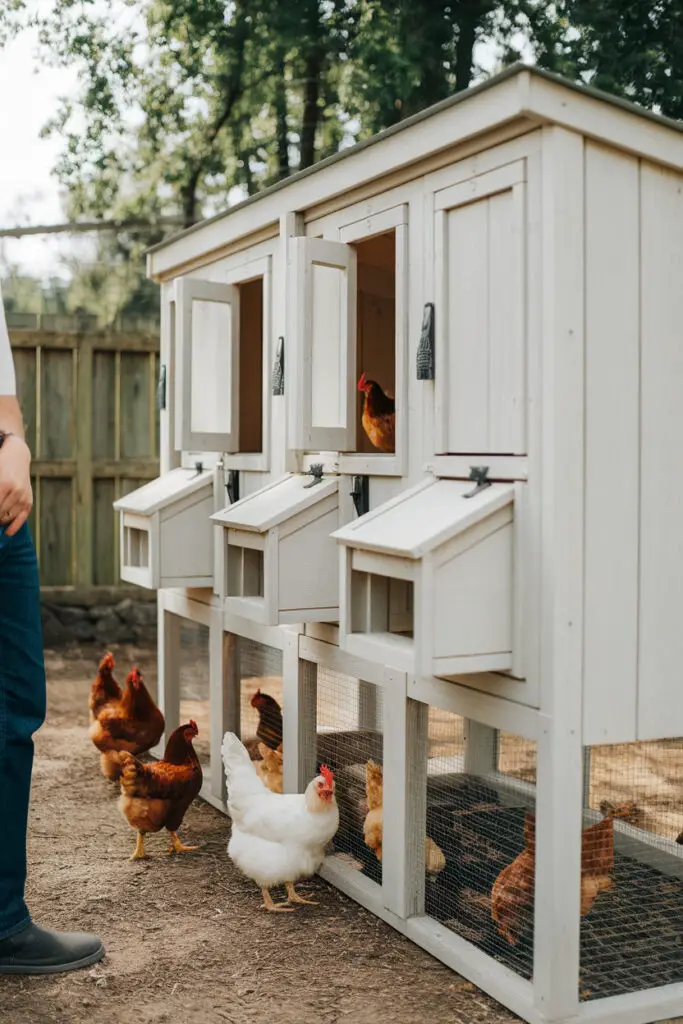
Before we jump into the fun part—the designs!—let’s cover the basics. Building a chicken coop isn’t just about throwing together a cute little house. It’s about creating a space that’s safe, functional, and easy to maintain. Here’s what you should think about first:
What Makes a Good Chicken Coop?
A solid chicken coop should meet your flock’s needs while making your life easier. Here’s what matters most:
- Protection from predators: Raccoons, foxes, hawks—you name it. Use sturdy materials, secure latches, and strong wire mesh. (Pro tip: skip chicken wire and go for hardware cloth—it’s much tougher. Learn more from Purdue University’s poultry protection guide.)
- Proper ventilation: Chickens release moisture and ammonia, which can build up fast. Good airflow prevents respiratory issues and keeps the coop smelling fresh.
- Easy access for cleaning: Trust us—you’ll thank yourself later. Include large doors, removable floors, or drop trays.
- Nesting boxes and perches: A comfy laying space = more eggs. Aim for one nesting box per 3–4 hens and place roosts higher than the nesting boxes to prevent sleeping in them.
- Space requirements: Don’t overcrowd! Cramped chickens = cranky chickens.
Looking for coop planning tips that fit into your yard? Don’t miss our post on How to Design the Best Chicken Coop and Garden Layout Ideas.
How Big Should a Chicken Coop Be?
The size of your coop depends on your flock:
- Indoor space: Plan for at least 3–4 square feet per chicken inside the coop.
- Outdoor run: Chickens need 8–10 square feet each to roam and scratch outside.
- Mini coops vs. walk-in coops: Smaller coops work great for 2–4 hens, but if you’re planning to expand or want more headroom, go for a walk-in style.
If you’re working on a tight budget, building a run separately can save you money. Learn how in our guide: How to Make a Budget-Friendly DIY Chicken Run.
Where Should You Put a Chicken Coop?
Location matters more than you’d think.
- Shade and drainage: Choose a dry, slightly elevated area to avoid flooding. Bonus points for some natural shade during summer.
- Close to your house: Makes egg collecting and maintenance easier—especially on rainy or snowy days.
- Noise and neighbors: Chickens aren’t that loud, but roosters sure are. Be mindful if you live close to others or within city limits.
Should You Build or Buy a Chicken Coop?
Here’s the big question—go DIY or go prefab?
- DIY Pros: Customization, cost savings, and that sweet sense of accomplishment. You get full control over the size, materials, and layout.
- Prefab Pros: Saves time and effort. Many models are cute, compact, and easy to assemble.
- DIY Cons: Takes more time and effort (and a few YouTube tutorials).
- Prefab Cons: Less flexible in design, and may not last as long depending on quality.
Still not sure? Don’t worry—we’ll show you coop ideas that work for both approaches.
What to Consider When Choosing a Chicken Coop Design
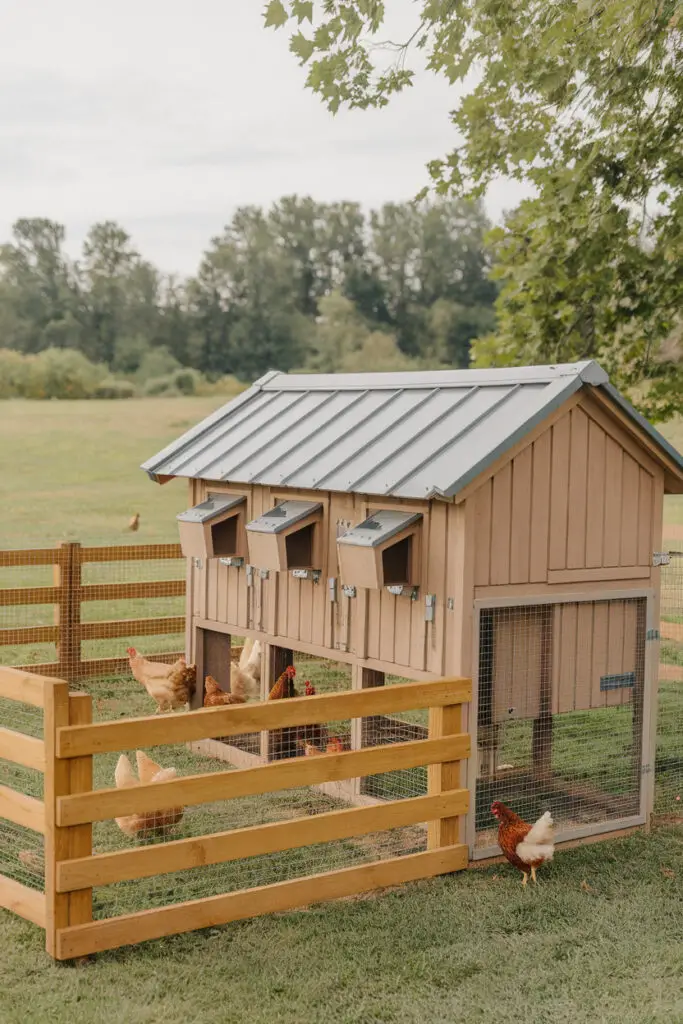
With so many cute, quirky, and clever chicken coop ideas out there, it’s easy to fall in love with how a coop looks. But before you decide on a design, it’s important to think about the details that really matter—like the materials, features, and long-term durability.
Here’s what to keep in mind when choosing (or building) a chicken coop that your flock will love.
Materials: What’s Best for Chicken Coops?
Your coop’s material affects everything—from how long it lasts to how well it protects your chickens. Here’s a quick breakdown:
- Wood: The most popular choice. It’s easy to work with, provides great insulation, and looks natural in any backyard. But it needs to be sealed and maintained to prevent rot and pests.
- Metal: Super durable and predator-proof, but it can get very hot or cold depending on the weather. Good ventilation is a must.
- Plastic: Lightweight, easy to clean, and won’t rot or rust. It’s a great low-maintenance option for smaller coops.
No matter which material you choose, make sure it’s predator-proof and can stand up to your local weather. Need help choosing the safest structure? Check out this practical guide from Backyard Chickens on predator-proofing coops.
🔧 Must-Have Features in Every Chicken Coop
A great coop isn’t just a shelter—it’s a well-oiled egg-laying machine. These are the features your coop must include for your flock to thrive:
- Nesting boxes: Soft, private spaces where hens feel safe to lay. One box per 3–4 hens is usually enough.
- Roosting bars: Chickens sleep off the ground, so sturdy roosts are essential. Not sure how to set them up? See our full post on Chicken Roost Ideas – Creative, Safe, and Comfortable Roosting Options to learn more.
- Ventilation: Keeps the air fresh and reduces moisture build-up—essential for your flock’s health.
- Drop-down doors or access hatches: Makes it easy to gather eggs and clean the inside without climbing in.
- Removable floors or trays: Cleaning is way easier when you can just pull out a tray and rinse it down.
Want something a little more creative than a basic box? You’ll love our roundup of 14 Creative Chicken House Ideas for Your Backyard Farm for inspiration that’s both practical and Pinterest-worthy.
13 Chicken Coop Ideas for Every Type of Backyard
From sprawling rural homesteads to compact city yards, there’s a chicken coop idea to suit every lifestyle. Whether you’re raising a small backyard flock or a larger group of hens, choosing the right coop design is essential for keeping your chickens safe, healthy, and happy.
Let’s explore some of the most popular (and practical) chicken coop ideas for every type of space.
1. The Classic A-Frame Chicken Coop
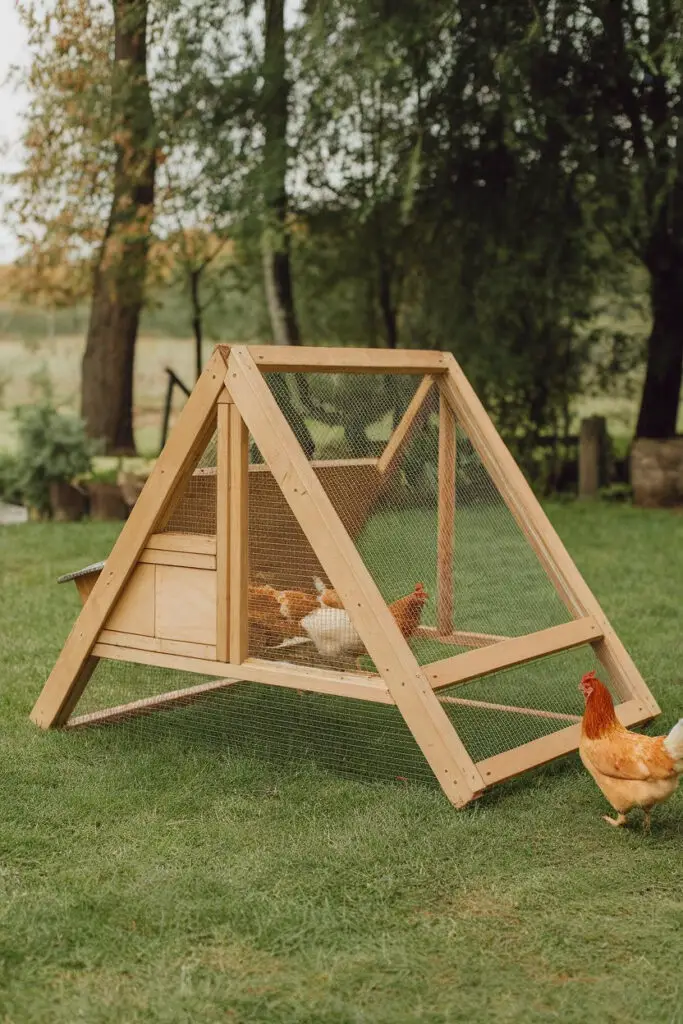
The A-frame chicken coop is a tried-and-true design that offers simplicity, function, and charm—all in one neat triangle.
- Why it works: Its sloped roof provides great drainage, making it perfect for rainy climates. The open triangular shape also allows for good airflow, helping to prevent moisture buildup and respiratory issues in your flock.
- Best for: 2–4 chickens, beginners, or those with limited DIY experience.
- Bonus tip: Add wheels to one side of the frame to convert it into a mobile chicken tractor!
The minimal materials and easy construction make it ideal for budget-conscious chicken keepers or first-time builders.
2. The Walk-In Chicken Coop

If you want to spend quality time with your flock (and not crawl around on your knees), a walk-in chicken coop is worth the space investment.
- Why it works: With ample headroom and interior space, it’s easier to clean, gather eggs, and interact with your hens without crouching or crawling.
- Best for: Medium to large flocks (5+ hens), families with kids, or people who value comfort.
- Bonus tip: Include a storage area for feed, bedding, and tools to keep everything organized in one place.
This type of coop can double as a garden shed, making it one of the most efficient coop ideas for serious backyard chicken owners.
3. Tractor-Style Chicken Coop (Mobile Coop)
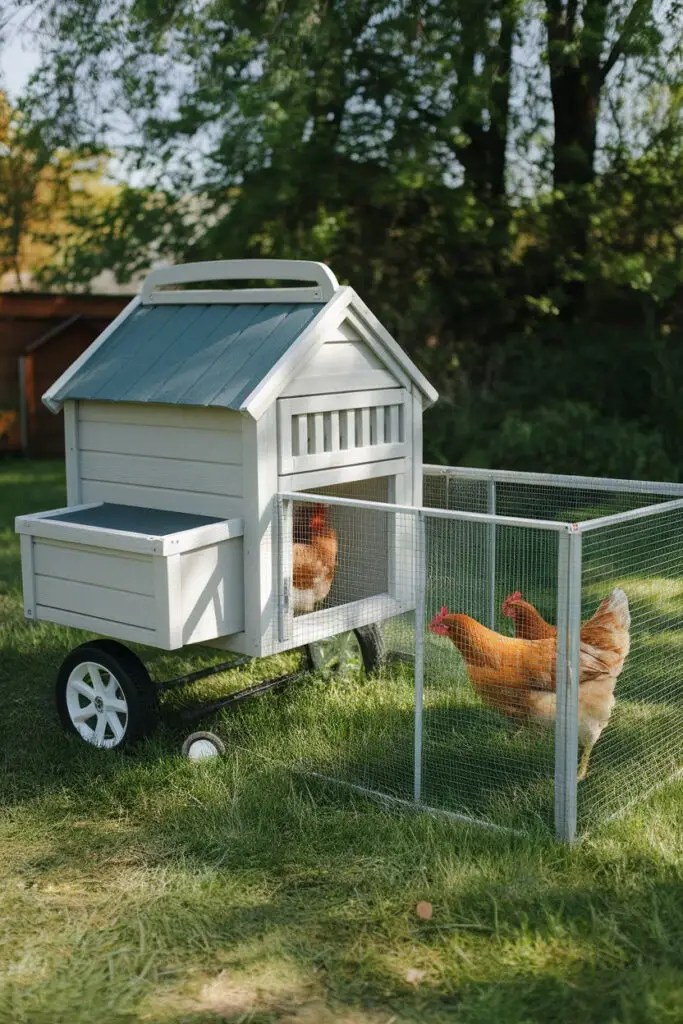
Also known as a chicken tractor, this coop is designed to be moved around your yard—giving your chickens access to fresh grass while spreading their droppings as natural fertilizer.
- Why it works: Chickens can graze on different patches of grass each day, helping with pest control and reducing the need to clean one stationary area.
- Best for: Small flocks (2–5 hens), flat yards, and those interested in regenerative gardening.
- Bonus tip: Use lightweight materials like PVC pipe or aluminum framing to make the coop easier to move.
Great for rotational grazing, this option keeps both your chickens and your lawn healthy.
4. Upcycled Pallet Chicken Coop
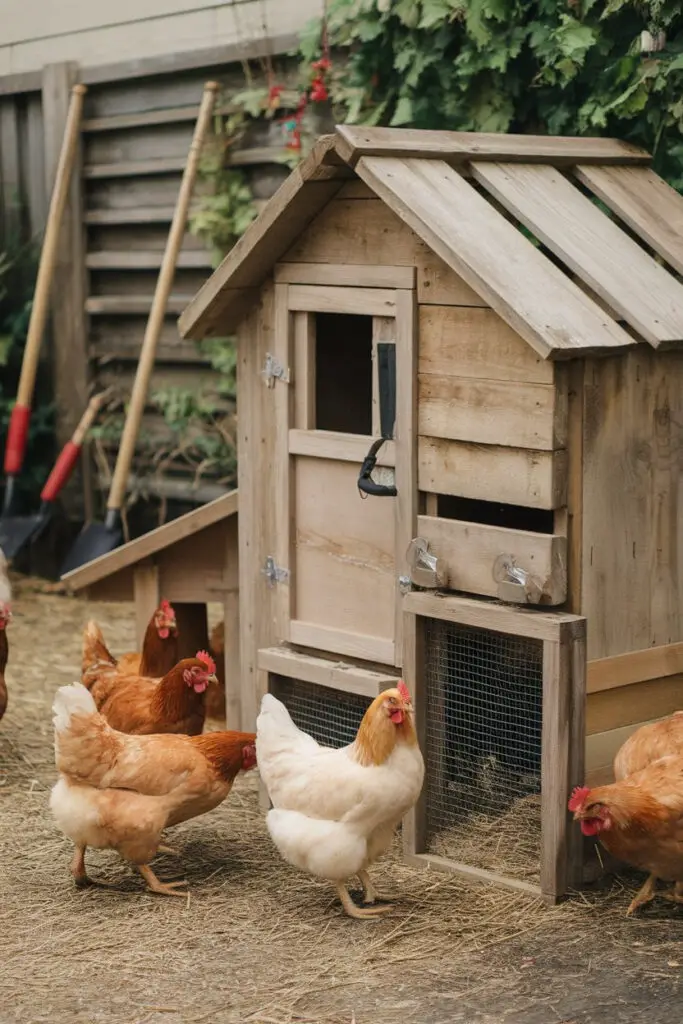
Why spend hundreds when you can build a coop for almost nothing?
- Why it works: Wooden pallets are often free or cheap, and they make a solid foundation for small to medium-sized coops when repurposed correctly.
- Best for: DIYers, budget-conscious homesteaders, or eco-friendly folks.
- Bonus tip: Choose heat-treated (HT) pallets instead of chemically treated ones to ensure they’re safe for your flock.
Add insulation, a tin roof, and a coat of paint, and you’ve got yourself a stylish, sustainable chicken home.
Here is a step-by-step guide on building a DIY pallet chicken coop.
5. Chicken Coop With Run Attached
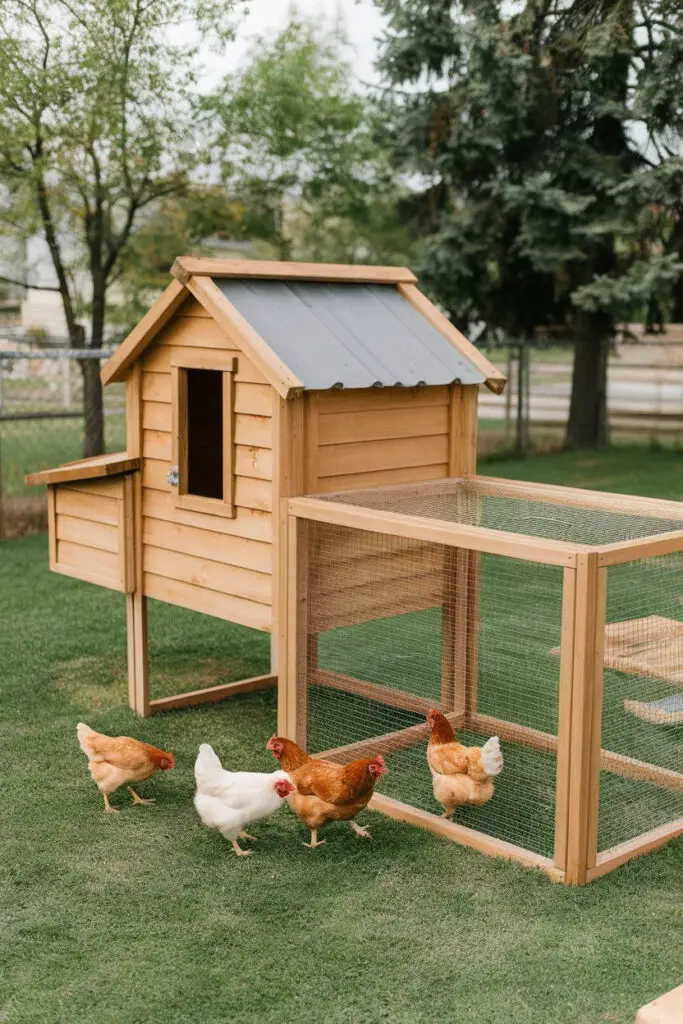
This all-in-one setup combines the indoor living quarters with an outdoor space for scratching, pecking, and sunbathing.
- Why it works: Your flock stays protected 24/7 while enjoying fresh air and exercise. It’s the perfect solution for keeping chickens safe from predators and preventing them from digging up your garden beds.
- Best for: Small to medium flocks, families with children, and suburban backyards.
- Bonus tip: Cover the run with chicken wire or hardware cloth for added security from hawks, raccoons, and stray dogs.
This design is especially useful in neighborhoods where free-ranging isn’t allowed or practical.
6. Small Urban Chicken Coop
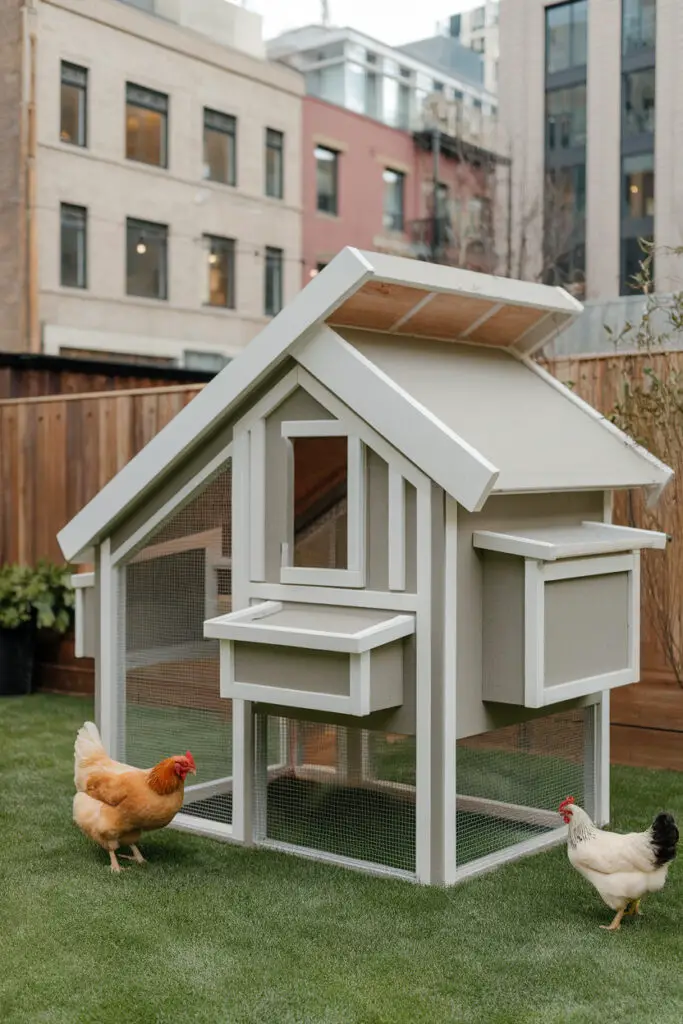
If you live in the city but dream of collecting fresh eggs every morning, a small urban coop is your best bet.
- Why it works: These coops are compact, often built vertically to save space, and designed to meet local zoning and noise regulations.
- Best for: 2–3 hens, rooftops, balconies, or tiny backyards.
- Bonus tip: Add a green roof with herbs or flowers to beautify your space and keep the coop cool in summer.
Urban coops can also be stylish—modern designs blend right into city landscapes and won’t upset your neighbors.
7. Raised Chicken Coop on Stilts

Want a coop that stays dry and clean even during a downpour? Go with a raised chicken coop.
- Why it works: Elevating the coop improves airflow, protects it from flooding, and deters ground-based predators like rats or foxes. The space underneath can also be used as a shaded area or dust-bathing zone.
- Best for: Wet or flood-prone areas, and anyone dealing with burrowing pests.
- Bonus tip: Make sure your ramp is not too steep—use cleats (small wood slats) so your hens don’t slip on the way up.
This clever design maximizes vertical space while minimizing mess and moisture below.
8. Chicken Coop With a Green Roof

Looking for a coop that’s both practical and pretty? A green roof might be your new favorite idea.
Why it works: Green roofs add an extra layer of insulation, helping to regulate temperature inside the coop all year round. Plus, you can grow shallow-rooted plants like herbs or flowers right on top—perfect for pollinators and backyard beauty. It’s functional, eco-friendly, and just downright cool.
Best for: Warmer climates, eco-conscious owners, or anyone who wants a coop that looks like it belongs in a garden magazine.
Bonus tip: Install a waterproof liner before adding soil and plants to prevent moisture damage to the roof.
9. Converted Shed Chicken Coop

Already have a small shed sitting in your backyard? You’re halfway to a chicken coop.
Why it works: Sheds offer a sturdy structure with plenty of space for nesting boxes, roosts, and feed storage. Instead of building from scratch, you just retrofit what you’ve got. It’s cost-effective and roomy—great for folks with a growing flock.
Best for: Medium to large flocks, colder climates, or anyone who wants a fast coop upgrade without a full build.
Bonus tip: Add windows or vents for airflow and natural light—it keeps the space fresh and your hens happy.
10. Chicken Coop With Storage Area
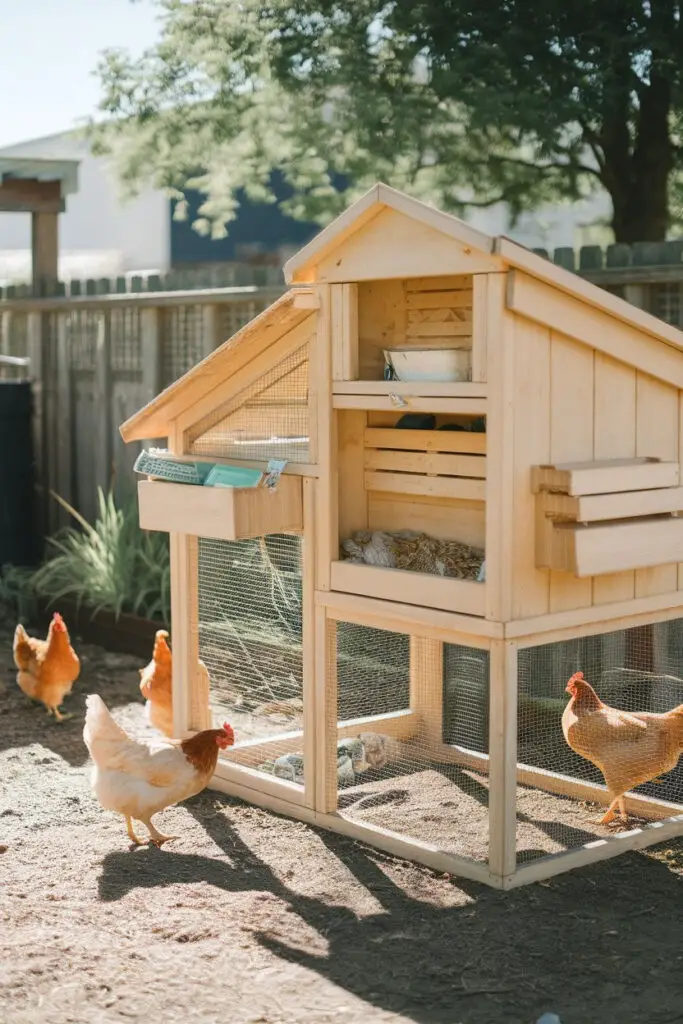
Everything in one place—that’s the beauty of a coop with built-in storage.
Why it works: Whether it’s feed bags, tools, or egg baskets, having storage space right inside or next to your coop cuts down on clutter and makes daily chores quicker. No more running back and forth to the shed or garage.
Best for: Backyard chicken keepers who love convenience, tidiness, and efficiency.
Bonus tip: Use waterproof bins with tight lids to keep feed dry and pests out.
11. Decorative or “Cottage” Style Coop
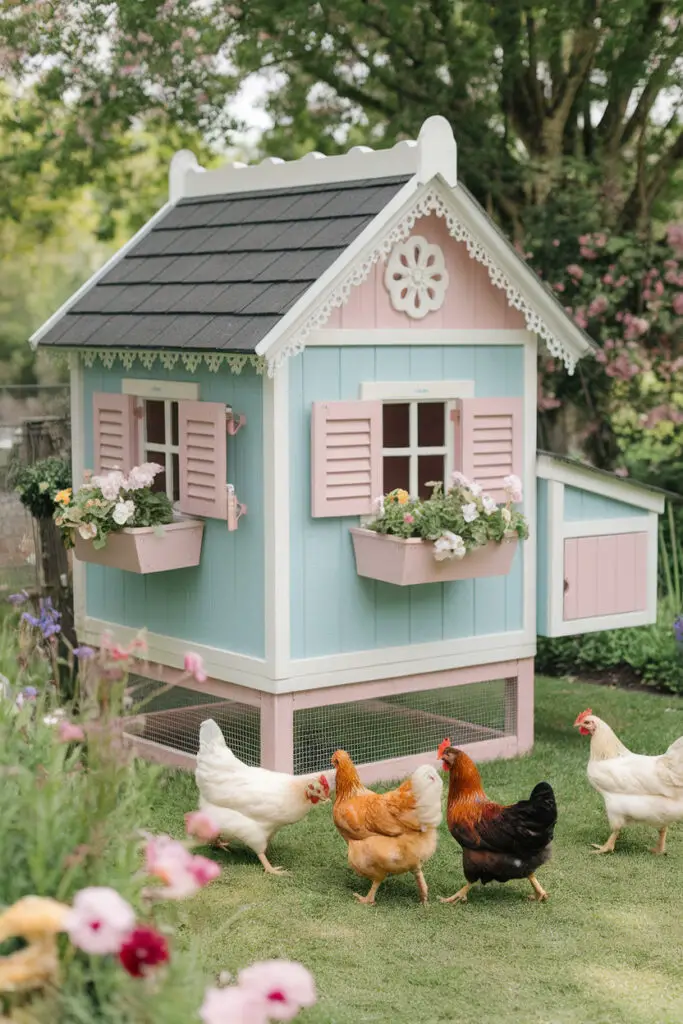
This one’s all about charm—because who says a chicken coop can’t look amazing?
Why it works: Cottage-style coops bring aesthetics and personality to your backyard while still keeping your hens comfortable and secure. Think cute trim, window boxes, and a cozy design that blends right into a landscaped yard.
Best for: Stylish setups, suburban backyards, or anyone wanting to keep things pretty and practical.
Bonus tip: Make sure your design choices don’t sacrifice function—ventilation, access, and durability should still come first.
12. Chicken Coop With Automatic Doors & Smart Features

Tech-savvy chicken keeping is totally a thing now.
Why it works: Automatic doors take the pressure off your schedule by opening and closing based on light or timers—keeping your flock safe even if you forget. Some coops come with motion-sensing lights, fans, or even mobile monitoring systems.
Best for: People with busy lifestyles, travelers, or anyone who wants peace of mind without micromanaging the coop.
Bonus tip: Choose a solar-powered option if your coop is far from a power source.
13. Modular or Expandable Chicken Coop
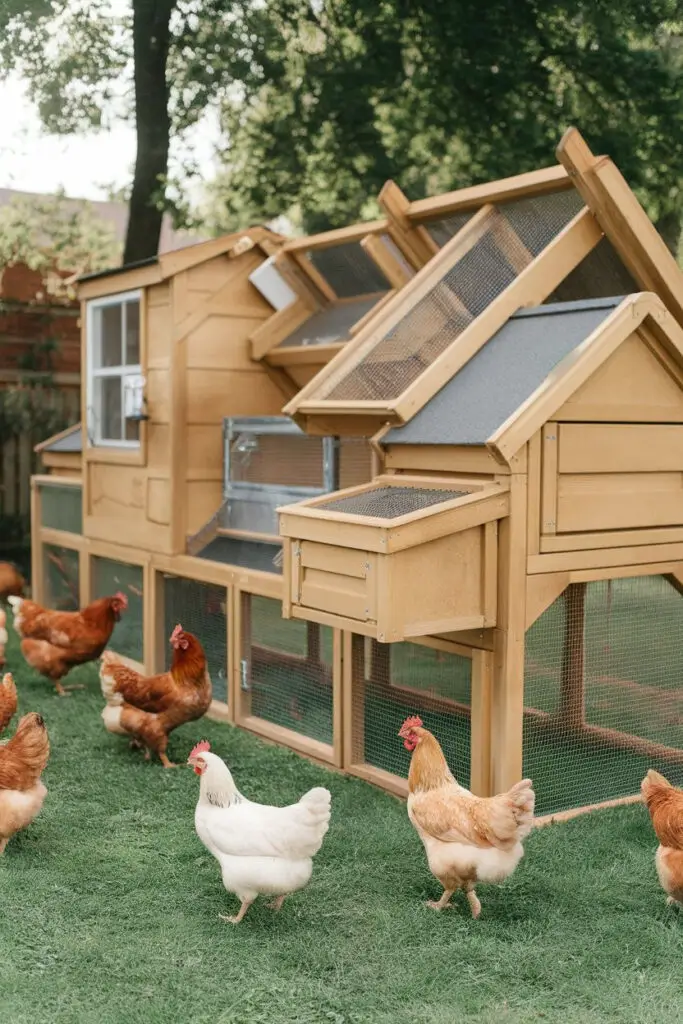
Future-proof your flock with a setup that grows with you.
Why it works: Modular coops are flexible—you can start with a small structure and add extra space, nesting boxes, or runs as your needs change. This saves time and money compared to rebuilding every time your flock grows.
Best for: New chicken owners, expanding flocks, or anyone who prefers to upgrade in stages.
Bonus tip: Look for models with interchangeable panels and easy-attach extensions to keep expansion stress-free.
FAQs About Chicken Coop Ideas
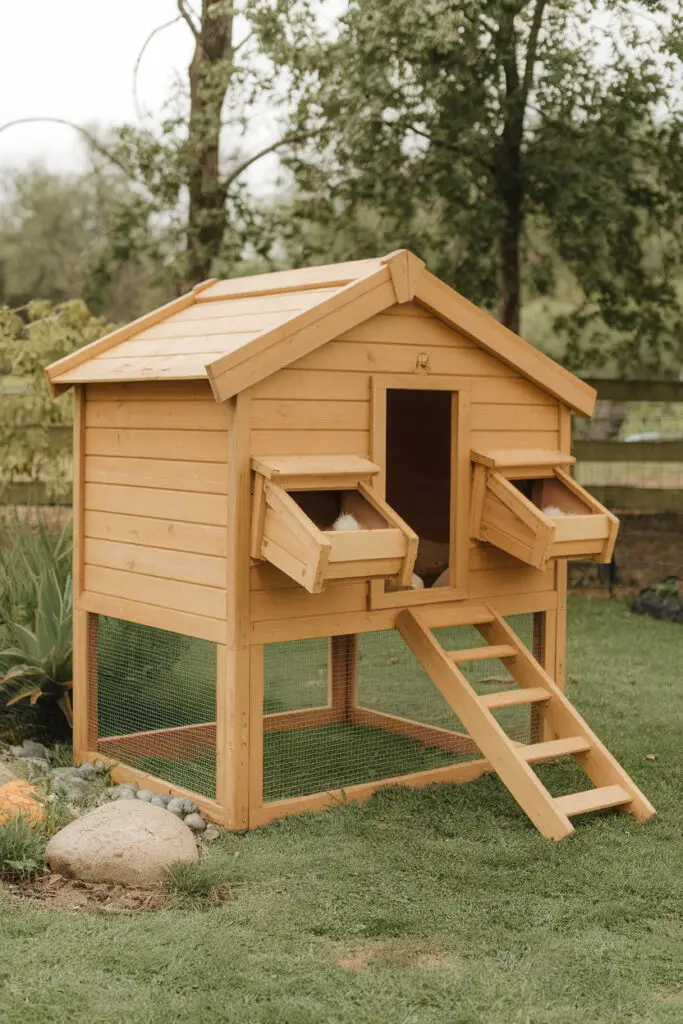
How Many Chickens Can I Keep in My Coop?
The number of chickens your coop can house depends on the square footage and run size.
Based on square footage:
A general rule of thumb is 3–4 square feet per chicken inside the coop. For example, if you have 6 chickens, you’ll need at least 18–24 square feet of space in the coop. If you’re adding an outdoor run, you’ll want 8–10 square feet per chicken outside.
Impact of run size:
The run is just as important as the coop itself. It gives your chickens space to roam and forage, which keeps them healthy and happy. So, while your hens may love to snuggle up, they’re not fans of feeling cramped—keep the space roomy for the ultimate chicken happiness. 🐔
How Often Do You Clean a Chicken Coop?
Cleaning your chicken coop regularly is essential for keeping your chickens healthy and preventing bad odors. No one wants to live in a stinky henhouse (especially not your chickens).
Weekly tasks vs. deep cleans:
Weekly tasks should include removing soiled bedding, checking for any built-up waste, and refilling food and water stations. For a deep clean, aim to do this every 4-6 weeks or whenever the bedding starts to look like it could be its own ecosystem. A deep clean involves removing all bedding, scrubbing surfaces, and disinfecting to kill germs. Because chickens are classy, they deserve a sparkling clean home.
Easy-to-clean design tips:
Choose removable trays for easier cleaning, install drop-down doors for access, and use slanted roofs to prevent dust and debris from collecting. Bonus points if you can make the coop look like it belongs in a Pinterest dream board.
How Much Does It Cost to Build a Chicken Coop?
The cost of building a chicken coop can vary depending on whether you’re going DIY or opting for a prefab model.
DIY vs. prefab:
A DIY chicken coop can cost anywhere from $200–$500 depending on the materials you use. If you’re upcycling wood or using scrap materials, it can be even cheaper! Prefab coops, which come preassembled or in kits, range from $500–$1000, depending on the size, quality, and features. Basically, whether you’re going for a budget-friendly coop or the “chicken penthouse,” you’ve got options.
Average cost range:
For a basic DIY coop, you might be looking at around $200–$400. A larger, more elaborate prefab can range from $600–$1000 or more, depending on the features and materials. It’s a small price to pay for your chickens’ luxury, right?
How Do You Keep a Chicken Coop Warm in Winter?
Keeping your chickens warm during the cold months is crucial, but there’s no need to go overboard—chickens don’t need a heated spa, just a cozy coop.
Insulation options:
You can add foam insulation boards to the walls, especially if your coop is made of wood. Additionally, consider insulating the floor to prevent cold from seeping up. Think of it as a winter jacket for your coop!
Safe heating ideas:
If you live in a particularly cold climate, heat lamps or infrared heating panels can be used, but safety is key—be sure they’re placed properly to avoid fire risks. Also, chickens like it chilly but not freezing, so don’t overdo it—remember, they have feathers for a reason.
Natural light and draft protection:
Maximize natural light with windows or transparent roofing to help warm the coop naturally. Ensure that the coop is well sealed to avoid drafts, and use heavy curtains or tarps during the coldest months to keep the warmth inside. You don’t want your chickens complaining about the draft while sipping their morning coffee, right?
What Should You Not Do When Building a Chicken Coop?
Avoiding common mistakes can save you from headaches down the road—and trust me, chickens can be very picky about their living conditions.
Common mistakes:
- Poor ventilation: Without proper airflow, your coop can become damp and smelly, increasing the risk of disease. Make sure your coop has enough windows or vents. Your chickens will thank you for not giving them “chicken sweat” to deal with.
- Flimsy materials: Use strong, durable materials that can withstand weather and predators. A weak coop will not only be unsafe but can deteriorate quicker than a chicken’s willpower when they see a snack.
- Overcrowding: Chickens need space to move freely. Ensure the coop is large enough for your flock to prevent stress and health issues. Remember, the more room they have, the fewer chicken squabbles.


